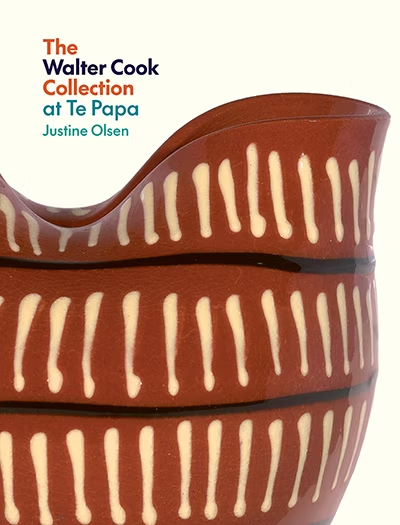Aventurine, Flambé and kingfisher blue are terms that won’t mean much to the average punter. However, for that most dedicated of collectors, the pursuer of rare and decorative ceramics, these words are touchstones, unlocking the secrets of alchemical processes that create brilliant glazes and treatments. They illuminate the pages of this fascinating account of the decisive role played by collectors in our culture – in this case Wellington-based ‘autodidact’ Walter Cook. Over four decades, commencing in the early 1960s and on a librarian’s salary, Cook amassed a world class collection of late 19th and early 20th century ceramics and glass which he donated to the National Collection, soon to become Te Papa, in 1992.
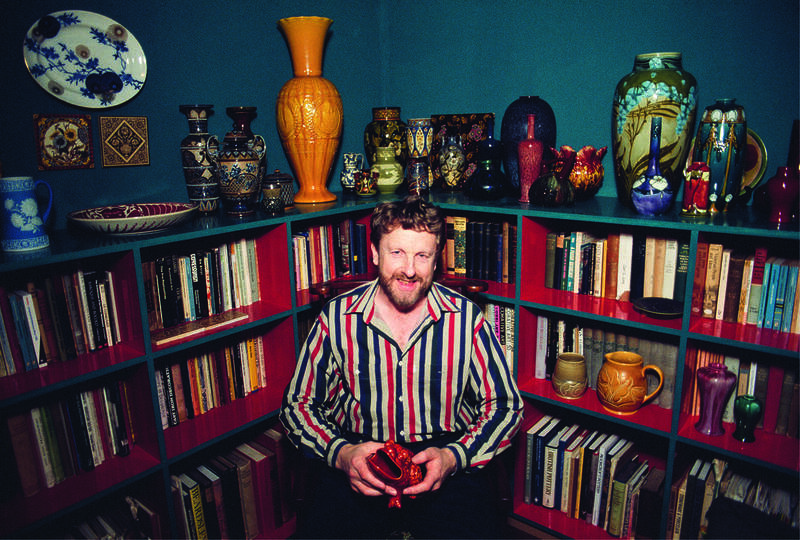
Walter Cook with his collection in his Thorndon home in the late 1980s, photographed by Grant Sheehan. Walter Cook private collection.
In 2025 we are in a moment where the value of culture, the making and the sharing of it has become – again – drearily contested as those spaces, actual and psychic, those rare nodes of joy and community where cultural meaning is incubated, are threatened in the name of defeating ‘wokeness’ and promoting equality.
If we cast our minds back to where this all began, we can wind the clock titled déjà vu back to 1991 and the ‘Mother of all Budgets’ authored by then Minister of Finance Ruth Richardson. ‘Ruthanasia’ remains to this day the heftiest bludgeoning of the ‘commonwealth’ that our body politic has endured by the neo-cons in living memory and a clear source of inspiration for the class of 2025.
Cook’s intention in gifting his collection of nearly 400 pieces to the nation was not then without political intent. In a 2012 RNZ interview, he described the gift as ‘the way I, an ordinary, powerless person, could give the fingers to Ruth Richardson and every value she stood for – that neo-liberal atomized self-interest. Because I don’t believe in that at all, and our cultural institutions stand as evidence that there is community and there is common purpose.’
Towards Modernism, however, is less a polemic and more an elegant love letter to the joys one collector found, and chose to share, amongst the forms and colours found in Art Nouveau glass, Scandinavian teapots and biscuit jars by the irrepressible British designer Susie Cooper (1902–1995).
Justine Olsen, Te Papa Tongarewa’s curator of Decorative Art and Design, explores the works of iconic designers in Cook’s collection – like Cooper and Clarice Cliff, William De Morgan, Keith Murray, Christopher Dresser and Royal Copenhagen stars Inge-Lise Koefoed and Berthe Jessen. Olsen deftly teases out wider contexts and readings for many of the decorative pieces. Among her favourites is ‘a tall Tenera Vase by Danish designer Berthe Jessen in 1963 … It’s a delicate yet lush design. The vase encapsulates the story of how Royal Copenhagen developed a fresh approach to design by hiring young women artists straight from art schools across Scandinavia. It has that art to industry approach.’

Vase, ‘Tenera’ ware, 1963. Manufacturer: Royal Copenhagen, Denmark. Designer: Berte Jessen. Artist/maker: Nils Thorsson. Ceramic, faience, 363 x 143 x 125mm, CG001892.
Cook, born in 1941, was raised in a fertile theological and creative environment. His father, George, was an Anglican curate and his mother, Hinehauone Coralie Cameron, was a talented artist and printmaker. The Te Papa collection holds a number of her woodblock prints: they are reminiscent of those by leading mid-century figures such as A. Lois White and Adele Younghusband.
Young Walter’s fascination with collections and museums was ignited as a four-year-old after a visit to the Wanganui Museum with his mother to see ‘a cabinet of curiosities’. He ‘returned home and started my own museum, and from then on, museums became places of pilgrimage – sites of an ultimate reality to which I could only aspire.’
As a teenager he frequented Wellington’s second-hand stores and bookshops, building his knowledge and developing an early love of English Art Nouveau artist Aubrey Beardsley and the philosophy of poet and designer William Morris, godfather of the English Arts and Crafts movement. Cook began collecting Art Nouveau as ‘a way of touching the reality of Morris and the Pre-Raphaelites in far off New Zealand.’
His first purchase in 1961 was a Tudric hot-water jug by Liberty & Co dating to around 1903 from the shop Gallery 36 on Vivian Street, Wellington. This, he said, ‘initiated me into the addictive habit and thrill of hunting quarry in secondhand shops.’
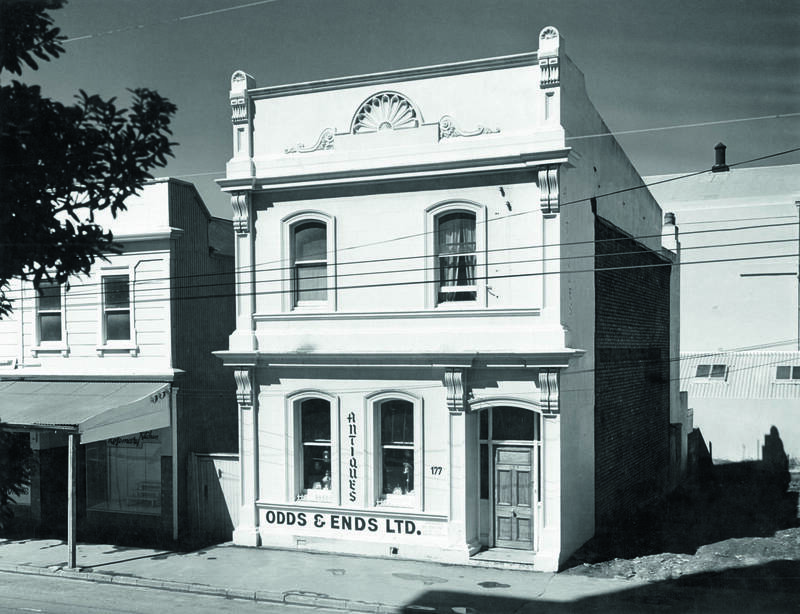
The Wellington antiques shop Odds & Ends, photographed by Charles Fernley around 1960. Wellington City Library (50003-2032).
From this point Cook the collector worked his way through the 20th century as design trends became evermore progressive and future-facing, racing towards the modernism and the utopian optimism suggested by the book’s title. From the Empire-infused fascinations with Japonisme and the classical forms of Royal Doulton and Moorcroft to the fusion of Medieval fancy and Art Nouveau of Tudric pewter and Minton ‘Secessionist’ ware, Cook looked to more flamboyant movements that flowered in the Art Deco years after WWI when Susie Cooper, Charlotte Rhead and Truda Carter along with Clarice Cliff were leading figures in the design world.
New Zealand design enters the picture in the second half of Towards Modernism in the form of the creamy and minimalist forms of Crown Lynn vases by Ernest Shufflebotham, which continue to be highly sought after by 21st century collectors.

Vase, c.1948. Manufacturer: Crown Lynn Potteries Ltd, New Zealand. Thrower: Ernest Shufflebotham. Ceramic, 230 x 235 x 235mm, CG001939.
Today much of this collecting has moved online, and that cagey, gregarious milieu of collectors and specialist dealers known as the trade is now defunct. Towards Modernism acts as their requiem, following the collector’s quest amongst the shelves of tony antique dealers and bric-a-brac emporiums alike for a prize piece of Minton or an unusual example of Scandinavian design at Paddy’s Market or a long departed ‘Curiosity’ shop. Collector-centric shops, happy hunting grounds for Cook and his cohort, such as Odds & Ends, Mr Smiles and Willbank Court Antiques from whom Cook acquired a fine high-fired Ruskin Pottery sang de boeuf (bull’s blood) squat vase (1912) in 1985 emerge as vital arms of the transmission of information, enthusiasm, gossip and referrals.
One of the many delights of Towards Modernism are the wry captions noting when, where, from whom and how many readies Cook had to part with to add key pieces to his collection. In 1982, a relatively lavish $800 was paid by Cook to dealer Gary Langsford to acquire a prize William De Morgan dish. Frequently though, a purchase was accompanied by the delicious thrill that collectors experience when snaffling a treasure for a bargain price. In 1972, Cook paid just $3 for the lovely Watcombe Pottery Palm pot with its distinctive shimmering green glaze from Marsden Antiques in Wellington, one of the few originals still currently trading, now in Featherston in the Wairarapa.
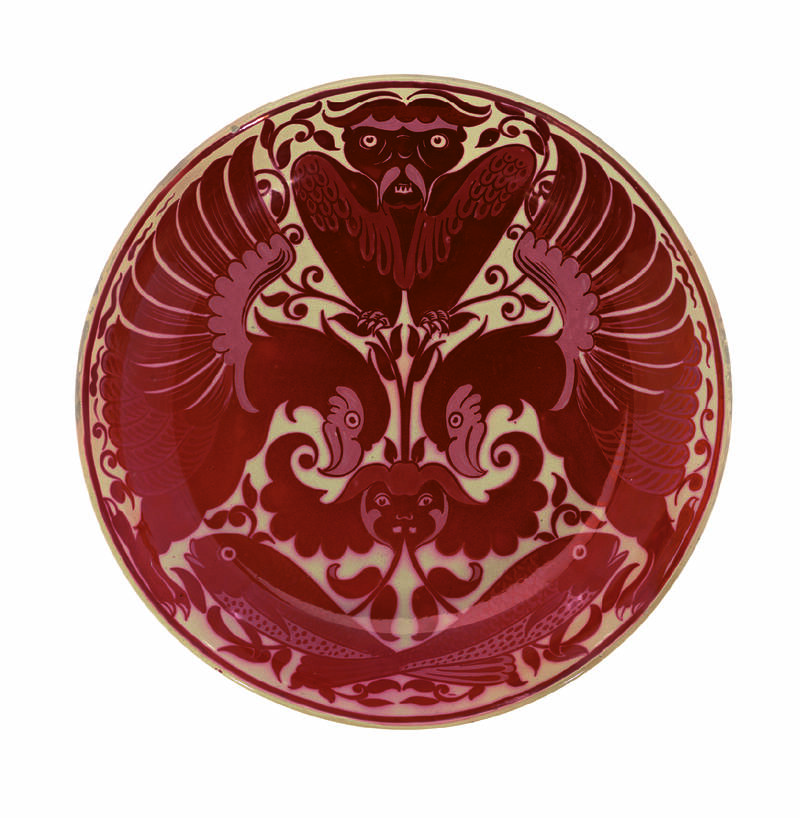
Dish, c.1885. Manufacturer: William De Morgan, England. Designer: William De Morgan. Earthenware, red lustre glazes, 53 x 362 x 362mm, CG001805.
Cook spotted another rare treasure in 1983 in a junk shop on Ponsonby Road. It was a Sea Urchin form double-spout jug by the iconic Christopher Dresser dating to the 1880s. Cook paid $18 for it; it is now valued at around $3000.
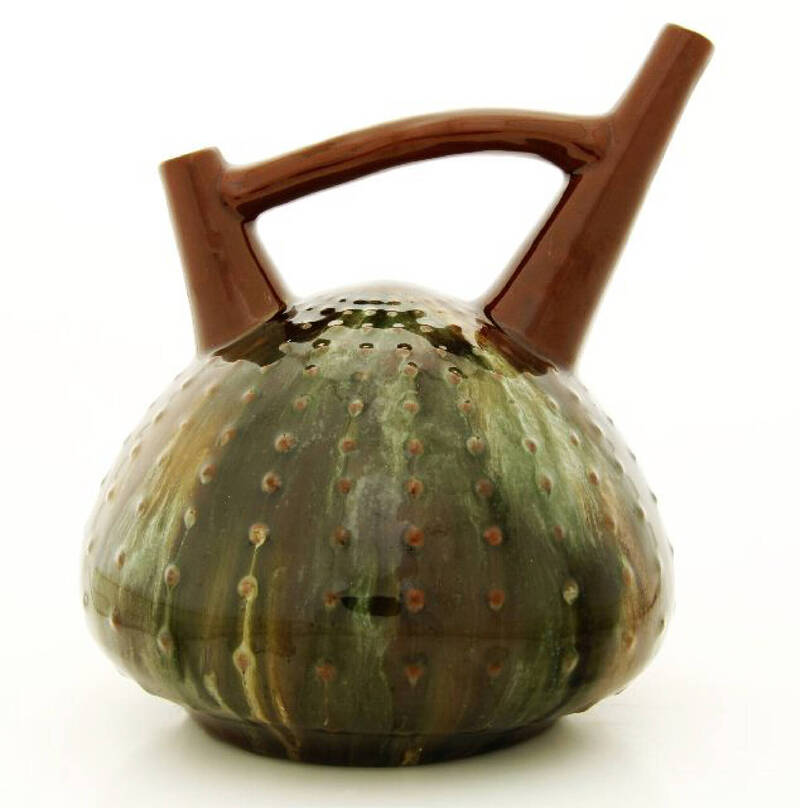
Jug, 1879–82. Manufacturer: Linthorpe Art Pottery, England. Designer: Christopher Dresser. Earthenware, glazes, 180 x 165 ×157mm, CG001806.
In my experience as a collector, and in engaging with them as fellow travellers and clients during over a decade as Managing Director of an auction house, these singular individuals are united by a desire to wring sense from the conveyor belt of the quotidian and divine. They are driven by the taxonomic urge: the need to comprehend and order the culture around them. The most dedicated and inspired such as Cook end up making good on those aspirations. He writes that he intended this collection to be ‘an anthology of changes in taste and style in the applied arts – a record of the constantly shifting idea of the “modern” and a way of entering into the meanings of what this implied at different times.’
Towards Modernism is the ultimate collector’s Best Bets. Author Olsen has paced the book around the big structural shifts of design movements over a century from 1880 to 1980 and the glossary of terms and references is an education in and of itself. Across 400 pages of meticulously catalogued, referenced and illustrated applied arts, Towards Modernism breathes life into the communion of art and industry that Christopher Dresser’s seminal text Principles of Decorative Design articulated in 1873 at the dawn of the ‘moderne’ – that such a union could create ‘Truth, beauty and power.’


